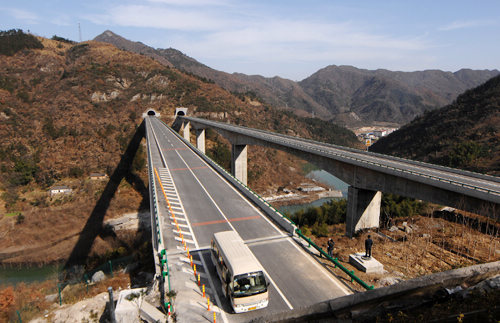|
 |
|
LEAD TO PROSPERITY: The new expressway in the Dabie Mountain old revolutionary base area, connecting it with the outside, has been put into use (WANG LEI) |
In a bid to combat the Kuomintang regime and Japanese aggression, Mao Zedong and other leaders of the Chinese revolution set up many revolutionary base areas from 1927 to 1945.
During wartime, those areas provided labor, material and financial resources to the Communist Party of China (CPC) and the army under its leadership to help them persist in their struggle. However, since most of these revolutionary base areas are scattered among mountainous areas with inconvenient transportation, they have lagged behind in economic and social development over the past decades.
China is resolute to develop old revolutionary base areas in order to change their impoverished status and give them access to the fruits of China's economic development. On March 2, the State Council gave the green light to the development plan of the Shaanxi-Gansu-Ningxia old revolutionary base area, which is jointly formulated by the National Development and Reform Commission (NDRC), China's top economic planner, and the Development Research Center of the State Council. The plan is the first of its kind to accelerate the development of old revolutionary base areas.
The Shaanxi-Gansu-Ningxia old revolutionary base area embraces 17 cities and counties scattered in northwest Shaanxi and Gansu Provinces and the Ningxia Hui Autonomous Region, including Yan'an, the seat of the CPC headquarters in 1937-48, Qingyang and Wuzhong. Covering a total area of 192,000 square km, the area has more than 17 million people.
According to the plan, the Shaanxi-Gansu-Ningxia area will accomplish several goals by 2020, including the establishment of a modern energy industry system, a basic public service network that will reach the national average level and a well-off society. In the plan the Central Government also lists 22 favorable policies in five major categories, namely the fiscal and taxation system, finance, investment, land and resources, ecological environment and social support, to make sure those goals be smoothly accomplished.
There are over 10 large revolutionary base areas in China. Currently, plans for the central Soviet area (scattered in Jiangxi and Fujian provinces) and the Dabie Mountain old revolutionary base area (scattered in Anhui, Hubei and Henan provinces) are also being formulated.
Those areas have made a huge contribution to the founding of New China. Today, the Central Government has set the goal of improving the livelihood of the people there, said Li Yingming, Deputy Director of the Department of Western Region Development under the NDRC.
Old revolutionary base areas are blessed with abundant natural resources. For instance, the Shaanxi-Gansu-Ningxia area has rich mineral resources, such as coal, petroleum, natural gas, rock salt and limestone. The Xifeng Oilfield, the largest onshore oilfield in China, is located in the area. The area also has 194.9 billion tons of verified coal resources, one seventh of the total in China, and one third of the country's total rare earth production capacities. The area also boasts ample new energy resources, such as wind and solar energy, offering a promising future for wind and solar power generation.
The city of Qingyang in Gansu Province is a key spot in the Shaanxi-Gansu-Ningxia area because that's where the first Soviet regime in northwest China was established in 1934.
Qingyang has rich natural resources. "Although people's livelihood has been greatly improved after years of development, we still have quite a long way to go compared with other regions. More effective policies should be adopted to facilitate its leaping development," said Zhou Qiang, Mayor of Qingyang, at a press conference for the development plan of the Shaanxi-Gansu-Ningxia old revolutionary base area on March 18, 2012.
Early in 2008, Qingyang was the first to call for a promotion plan for the Shaanxi-Gansu-Ningxia area and has received warm feedback from other cities and counties in the area.
According to Zhou, major difficulties that old revolutionary base areas face include poor infrastructure, fragile ecological environment, delayed development of natural resources, underdeveloped industrial structure and a low level of opening up.
|
